#A FOSSIL GINKGO LEAF
Text


A FOSSIL GINKGO LEAF
Colorado, USA
From the Paleocene (circa 58 - 55 million years ago) the clearly defined 31⁄4-inch wide Ginkgo cranei with well preserved striations, on original matrix. Reverse of matrix three further partial specimens of Ginkgo cranei.
63⁄4 x 67⁄8 x 3⁄4in. (17.1 x 17.5 x 1.9cm.).
#A FOSSIL GINKGO LEAF#colorado#paleocene period#ginkgo cranei#fossils#archeology#archeolgst#history#history news#ancient artifacts#nature
7K notes
·
View notes
Text
i'm back on my regularly scheduled insanity with my regular guy, a certain general from the luofu
recently i saw a post about the resilience of ginkgo trees and then i ended up doing some more reading into the history of ginkgo trees and honestly it might be a stretch but i am drawing some parallels here
ginkgo trees are the only surviving species of their entire order, and have outlived many of the organisms in their ecosystems, including their pollinators, and have managed to survive this long because of their long lifespans which allowed them to just live until humans came along and decided that these trees were pretty and worth planting everywhere
the species has no close relatives because they all died (sound familiar? ok i'm sorry) and it is known as a living fossil, similar to horseshoe crabs because of how it has remained relatively unchanged over the course of its evolutionary history, all due to the species' extreme longevity and tenacity
that's the basics of it, and now we go into the "i've connected the dots/you haven't connected shit" phase of this post
ginkgo is a very obvious symbol on the luofu, appearing in marastruck soldiers, jing yuan's trailer, and, if i had better graphics, probably the particle effects in the exalting sanctum, though that's a bit more of a stretch
and also jing yuan literally takes a ginkgo leaf and puts it on the chessboard. it's right there
so clearly the really long life for a xianzhou general + everyone of his time being dead (except for maybe huaiyan? unconfirmed though i think) is really easy to draw parallels to
but i don't think ginkgo represents jing yuan necessarily, it feels like a more general symbol for the entire luofu as a whole, because in a way jing yuan and the luofu are one and the same
the luofu is currently in a period of relative stability despite having lost the vast majority of its military power due to both the sedition of imbibitor lunae and the shuhu thing that preceded it
and jing yuan is the single person responsible for tiding it over until the younger generation (yanqing, fu xuan, sushang etc) have grown up enough to be able to reliably take over the luofu
and like a ginkgo tree, jing yuan, the only one left from his time, stays with the luofu, waiting until the children are ready to step up and take the luofu to greater heights and back on the trail of the hunt
the marastruck and why they're represented by ginkgo is another question entirely that i cannot answer at this moment but yaoshi should've given the xianzhou people more long terminal repeats
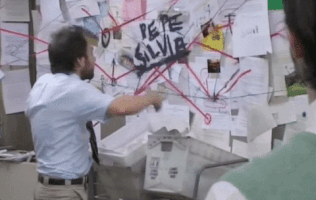
i'm sure i sound like this right now
29 notes
·
View notes
Text
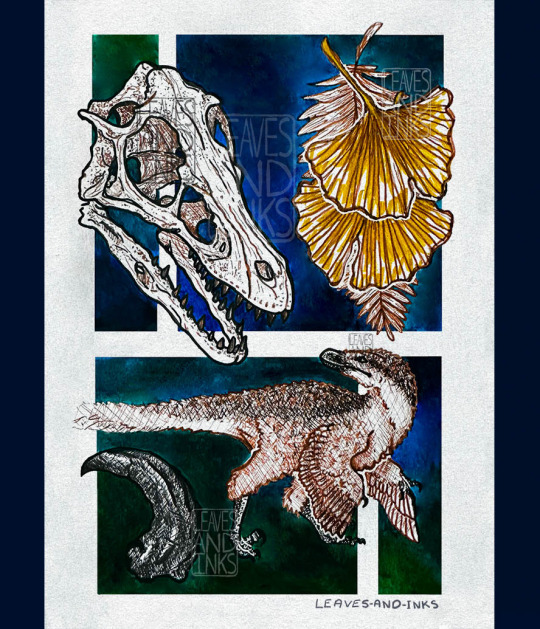


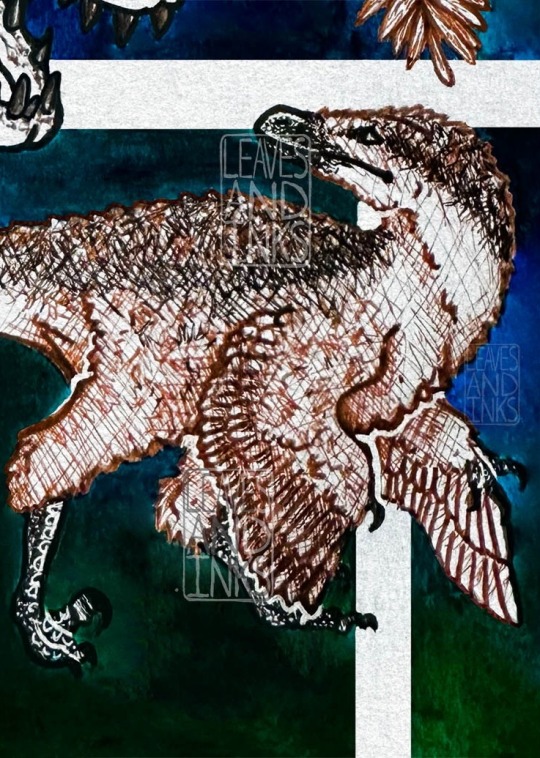
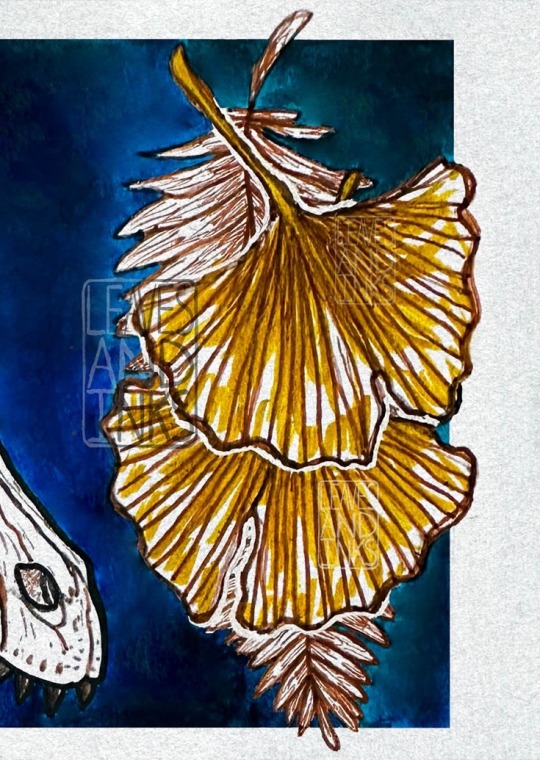
🌿 Old Bones, Old Souls 🌿
The world of velociraptor is buried deep, deep in time. There is so much we’ve learned about it, yet so much we don’t know, and may never know about this ancient animal.
Hi everyone! It feels good to finally post this!! I’ve been rather swamped, but updating my tumblr is one thing I can check off the list!! This piece has been done for a little while, but I’ve only just had time now to format it. I remember doing the rough sketch of this back in the fall and not being too thrilled, but I can now say that I’m really happy with how it came out! This piece also is next to the dragon “Emerald Mist” and I feel they pair really well together :)
This is the last piece to catch up to my other social media, so things will slow down again after this!! I have some plans in the works for the future, but unfortunately I don’t have much of a time scale on it because it depends on my health and my school work. Regardless of when exactly, I am excited to make some new work!! :D
[ID: Sketchbook page with digital alterations featuring a velociraptor skull, ginkgo and fern leaves, a fossilized velociraptor claw, and a feathered velociraptor. The page is done in various colors of ink, the subjects being in black and sepia liners, while the background is made up of blue and green squares and rectangles, overlapping behind the subjects. In the top right is a velociraptor skull, facing 3/4 right and down. It is made mostly out of black lines, but with shading and details done in sepia ink. Its mouth is slightly open, and it is missing some teeth. It is also missing it bony eye supports. it overlaps the background shapes on the top left of the skull, along with the lower jaw, and bridges the gap between the two top shapes in the middle of the skull. Next to it on the righthand side is the gingko leaves and fern leaf. It is laid out vertically, the fern leaf, drawn in sepia ink and behind the two gingko leaves. The top gingko leaf overlaps the bottom one, pointing in slightly different directions. The leaves are also done in sepia ink, having white outlines to better differentiate them, along with sketchy yellow ink coloring. The leaves break the shape on the top, right side, and bottom, and only overlaps the one square. In the bottom left corner is a shaded study of a velociraptor claw fossil. It is completely done in black in, white a thick black outline. It only overlaps the lower square at its tip, which points left. The final drawing is a mostly full body sketch of a feathered velociraptor, cropped only at its tail, which fades out to the left side of the page. It its a side view of the raptor, who faces right. However, it looks over its shoulder to the left of the page. It is slightly hunched over, its arms lowered. The left arm reaches slightly more out than the right one, and it also steps forward with the left leg. It is mostly drawn in sepia ink, however non feathered areas (mouth, legs) are done with black ink. It also has a back and sepia brindle pattern on its back, along with a black stripe that starts at its eye and goes to its tail. Its body overlaps on top of the two bottom shapes. The sketch and background shapes are on an off-white, paper textured background.
Image 2: Crop featuring the velociraptor skull. It gets the whole skull in the crop, along with the leftmost side of the gingko leaves and fern.
Image 3: Crop focusing on the fossilized velociraptor claw. The whole claw is in frame, along with a portion of the bottom half of the tail.
Image 4: Crop focusing on the feathered velociraptor. It gets its whole body in the frame, minus the tail. In the top left corner, the ends of the upper and lower jaw of the skeleton are visible, along with the end of the fern in the top right.
Image 5: Crop focusing on the gingko leaves and fern. They are entirely in frame, along with a portion if the upper jaw, just after the nostrils. /end ID]
#leaves and inks#art#illustration#drawing#animal study#vulture culture#sketchbook#sketchbook study#paleoblr#paleontology#paleoart#velociraptor#dromaeosaur#theropod#feathered dino#dino#dino art#dinosaur#dinosaur art#ginkgo#plants#plant study#skull#animal skull#fossil#fossils#q
103 notes
·
View notes
Text
On Beiguang & Ginkgo Leaves
Ginkgo leaves are a common motif when Beidou and Ningguang are drawn together in official art... but why is that?



Ginkgo: 銀杏 yínxìng, "silver apricot".
Its leaves are green in spring-summer, then turn yellow in autumn.
Ginkgo leaves are unique in that it's sometimes seen to split into two yet merge cleanly at the petiole, representing the union of duality (i.e. yinyang, one & two, life & death, etc). The leaves are also seen as a heart, giving rise to its symbolism of eternal love.
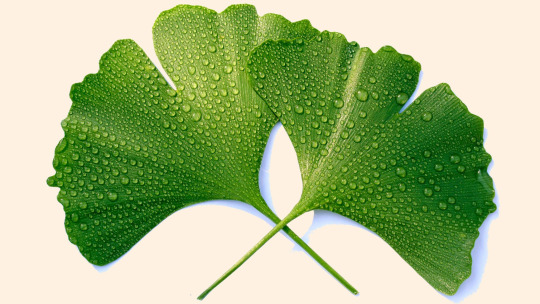
In autumn, the ginkgo leaves turn a lovely saffron yellow. When they do fall, they fall very quickly and in large numbers, so this has been affectionately termed the "golden rain"/黄金雨. As such, when we see large amounts of falling ginkgo leaves in art, it's safe to assume they may be alluding to a ginkgo tree nearby.

Beidou & Ningguang with others
When Ningguang & Beidou appear with other characters outdoors, the motif of ginkgo doesn't appear at all besides in Ningguang's design (we'll touch on that later). On the left, Ganyu & Ningguang's art show normal leaves instead of ginkgo; Beidou & Kazuha are on the Alcor in the art on the right so... no leaves.


Beidou & Ningguang together
With the ginkgo tree being a centuries-old symbol of yin-yang, falling ginkgo leaves only seem to appear when Ningguang & Beidou are together - a harmonious duality, opposing forces meant to complement each other to form a perfect whole (check out their yin/yang symbolism in this post too!).

It's also fascinating when we go back to their very first appearance in the JP promo: this is one of the few outdoor Beiguang pieces with no ginkgo motifs (indoor scenes being an exception).

After that, most subsequent Beiguang art started carrying ginkgo symbolism, even their chibi arts that were situated in nature. This could be a subtle hint of character development, perhaps?
Ningguang & her ties to ginkgo
Now, you might argue, what about Ningguang? She appears with ginkgo motifs just about every single time, and her hairpin carries a ginkgo leaf.


That's because ginkgo is more than just a symbol of eternal love. The tree is known as a "living fossil", thus it is a symbol of longevity, endurance, and hope. These are traits embodied in Ningguang's character - her whole life is testament to her endurance for a better future.
The description of her second Jade Chamber speaks of not just her power, but also the "adamantine will" of Liyue Harbour - endurance, hope, a legacy that outlives her.

As we've previously explored, Ningguang also carries lots of fenghuang symbolism, and the fenghuang is unique in that in itself it carries both yin-yang energy. But when met with the Chinese dragon, it forms the yin counterpart to the dragon's yang.
The ginkgo leaf is a symbol of yin-yang, two petioles merging into one, and thus it also accurately reflects the ancient perception of the fenghuang - where it was both yin and yang, before encountering the Chinese dragon.
So that's why you will see ginkgo leaf motifs frequently in Ningguang's solo art. Even her figurine and her character card in Genius Invokation TCG feature ginkgos, largely because of this endurance, longevity, prosperity and yin-yang symbolism that also reflect her metaphorical representation of the fenghuang.


But when it comes to ginkgo trees, you won't find a ginkgo tree without love contexts with her. In her 2022 birthday art, the ginkgo trees in the background are complemented by glaze lilies/motifs of love (we'll touch on lily language next!).

What does this mean?
This doesn't really mean anything, except that you can expect to see this ginkgo tree and falling ginkgo leaf symbolism to repeatedly occur in future Beiguang pieces, because it's intrinsically tied to their yin-yang relationship.
And unless Hoyoverse creates another yin-yang ship in another region, I highly doubt we'll see any other ginkgo leaf motifs with other pairings in Genshin till then!
Links:
Beiguang masterlist | Articles on ginkgo tree: 1, 2
#beidou x ningguang#beiguang#genshin impact#genshin analysis#ginkgo#art analysis#beidou#ningguang#otp dynamics#北斗#凝光#原神#genshin lore#genshin theory#chinese culture
144 notes
·
View notes
Text

quick doodle of woodsy with a ginkgo leaf fossil 💔💔
he feels great amounts of empathy for fossils sometimes he straight up bawls at the sight of a carbon fern fossil
12 notes
·
View notes
Text
Barosaurus and the Morrison Formation.





I just finished all my final projects and graduated from my high school, meaning i finally have the time to start posting again! This was a project I made for my high school art class where i had to illustrate something into 4 quadrants, each quadrant being done with differing materials. I was originally considering doing my sophont species: the Xy'ktals. But decided to do something more paleoart related since it was outside of my comfort zone at the time. This project took me almost 2 months to make, I started working on it in late march and submitted it in late may. And almost half of it was spent researching the life of this formation and trying to accurately reconstruct it. I hope you all enjoy this art piece
My Statement
As an artist who loves the natural world, I became fascinated with the field of paleontology long before I discovered my love for the possibility of alien life. I was introduced to the field by the Jurassic Park film franchise and was thrilled by all the big monsters made to scare. I bought their toys, watched most of the movies, and enjoyed most of it.
Eventually I phased out of Jurassic park. Many years later, when I was into designing aliens, I found a youtuber who made me rethink how I designed alien life. Teaching me that the human body plan is far from universal and we would likely make first contact with something that looked more like a jellyfish or a worm than a human.
While browsing through their other videos I found out they did paleontology, and once again my eyes were open. To see what the natural world looked like before mankind came to be was amazing. Getting to see plants and animals beyond my wildest dreams, so different they might as well be considered aliens. Yet they felt familiar, they felt relatable. That is what made me fall in love with the field.
Nowadays I casually look into paleoart, looking into the depths of time and into the earliest ages of life as inspiration for my own alien worlds. While working on this assignment, I realized that not many people are up to date with the modern idea of the prehistoric. Most still think of them as scaly screaming scrawny slaughter machines. Some might even still think of them as the lumbering dim-witted kangaroo-like lizards of the 1800s to 1900s. With this work i intend to change that
My goal with this assignment wasn’t just to draw dinosaurs, but to show everyone just how amazing the prehistoric world was. But most importantly, these were animals at the end of the day, not movie monsters made to scare. They lived simple lives of joys and sorrows, felt love, played with each other, and found happiness in the small things. They were no different than the animals of the modern world.
Introduction
To showcase this, I drew the many species that lived in the Morrison formation of Colorado, Wyoming, and Montana. A basin of sedimentary rock dating to the Jurassic period 150 million years ago. Back then this place was a semi-arid environment, home to swamps, floodplains, and savannahs. But this place didn’t look like modern savannahs now.
For one, angiosperms such as flowers, leafed trees, and grass only evolved some 10 million years after all the dinosaurs went extinct. Meaning almost none of the familiar plants were present in the jurassic. Instead of our familiar faces, Conifers, Cycads, and Ginkgos took the role of trees, horsetails were a common sight, and Ferns took the niche of grass. In fact Ferns were so prevalent they became their own biome known as the Fern Prairies
The animals are also far different too. Unlike the depictions spurred on by Jurassic park, of big, gaunt, and mindlessly ravenous reptiles designed to kill. Through finely preserved fossils we now know most of them were covered in varying degrees of feathers. Some may have had simple hair-like feathers while others were almost birdlike in appearance, since birds actually evolved from dinosaurs.
Pretty much every dinosaur that didn’t have a beak had lips covering their teeth. Their hands would have faced each other rather than pointing downwards. Lastly we know that pretty much all of them were covered in enough fat and muscle to not have every detail of their bones poking out like a starved animal
The winged bird like-creatures named Pterosaurs too have changed a lot. We now know they were also covered in fur, and were possibly brightly colored too. their hands faced each other in the same way the dinosaurs did. Surprisingly they walked on the balls of their feet like us, and some were even postured like us too.
Barosaurus: the main star
The dinosaur that’s the focus of this piece is a young male Barosaurus as he stands near a conifer tree. Relaxing in the cool moist air brought on by the passing rain of a Cumulonimbus cloud
Barosaurus was an enormous species of herbivorous dinosaur that helped define the Morrison formation along with many other species. They were a part of the clade Sauropoda, a group of herbivorous dinosaurs renowned for their extremely long necks and equally long tails.
Barosaurus wasn't the longest or the strongest sauropod. but it was still impressive at a staggering 82-89 feet long. This behemoth was so huge their front arm alone was as big as a human.
Most sauropods had a uniquely weird set of feet. The hind feet were round and had 3 toe claws that pointed outward. While the front feet were horseshoe shaped, with the fingers all fused together and an empty space at the center. Only the “thumb” has a claw while the rest of their fingers were bare, save for possibly a collection of jagged scales that aided in traction.
Like mentioned earlier, Barosaurus was an herbivore that specialized in high level browsing. They were also surprisingly flexible, the structure of their neck vertebrae gave them a wide range of motion, allowing them to eat tons of plant matter in wide sweeping motions without having to move an inch.
Despite their sheer size, the juggernauts of the Jurassic were still preyed on from time to time by Allosaurus and maybe Ceratosaurus. To counter this, the Barosaurus has a few weapons at its disposal, It could possibly rear up on its hind legs to make itself look even larger or even to stomp on incoming attackers. But its greatest weapon was its tail. It was thin and flexible, allowing the Barosaurus and its relatives to whip at their attackers with a thunderous crack, stunning the predators and possibly leaving long stinging cuts in them.
Speculated here, the Barosaurus was given a vibrant set of brown and black patterning as a way to distinguish themselves from other sauropods. They possess a large black dewlap to displace heat all in one area while the main body remains light in pigment and the head mostly white. Several Eye-like patterns run down the neck as a form of sexual display as they could potentially swing their neck around as a display of their flexibility to mates. The tail by contrast is a bright green as both a warning sign to predators and a way to communicate with other barosaurs. And long spines run from the head to the tip of the tail, making their whips even deadlier to any predator even considering going after them.
And now It's time to talk about all the other species that make this formation famous. Organized from left to right
Tile 1: Graphite pencil and Fine art pen
An Ophisthiamimus basks under the sun on a rock in the foreground. They were a 3 inch long reptile that specializes in insect feeding.
Despite its lizard-like appearance it was actually a Rhyncocephalian. A near extinct order of pseudo-beaked reptiles that dominated the early mesozoic, but were beaten back by tue lizards. The only surviving species of this clade is the Tuatara of New zealand
An old bull Brachiosaurus wanders across the drylands. They were a tall species of sauropod dinosaur that had a length of 57-72 feet long and weighed 28-47 metric tons. They were so big their forearms were as tall as an adult male. They Were herbivorous and browsed on high up plantlife such as the leaves of conifer, ginkgo, cycad, and tree fern leaves.
Speculated here, they could have had a large and flappy dewlap to displace heat. They may have also had several sets of inflatable neck sacs for sexual display since it was found internal air sacs ran down their neck and invaded their bones to reduce weight.
A small herd of very young Dryosaurs head towards the brachiosaurus for protection, in the same way a school of small fish orbit around a whale.
Dryosaurus was a species of small and nimble ornithiscian dinosaur that may have grown to be 7-9 feet long. They were Herbivores that fed on low lying plantlife, picking them out with their pointy beaks before chewing them with a set of cheek teeth.
So far no fossils of fully grown Dryosaurus have been found yet, so illustrated here instead are very young members of this species. Heavily Speculated here, they might've had a set of feathers turned quills on their tails and arms to stop larger predators from grappling on them. This feature was purely speculative and might've never existed on them.
A female Harpactognathus catches an unnamed early mammal from a hole in the ground. They were an extinct species of generalist pterosaurs that hunted small inland vertebrates and had a wingspan of 8.2 feet long. They were a part of the family Rhamphorynchidae, an early group of pterosaurs known for possessing toothy beaks and a long, thin tail.
Tile 2: Colored pencil and fine art pen
A young male Allosaurus tries to get with a female of the same species with his elaborate courtship dance. Flailing his arms, rhythmically stomping the ground and bowing his head to reveal the bright red crest, the female however is unimpressed.
Allosaurus was a species of 28-32 froot long theropod dinosaur that was one of 3 apex predators of the Morrison formation. They were discernible by the 2 pointy crests above their eyes. They specialized in hunting large prey such as stegosaurus and will sometimes come together in packs to even hunt sauropods such as Brachiosaurus and Barosaurus. They would've used their short but sharp teeth to slash into prey like a machete and used their short but muscular arms to hold onto their prey.
Speculated here, they could have sported black stripes and white splotches in an attempt at disrupting its outline and masking its eyes and ears. As well as having intricate mating dances that would've shown their flexibility and persistence.
A young female dryosaurus hides behind the Barosaurus' leg, waiting for the perfect opportunity to avoid the allosaurus and reunite with the herd.
A male harpactognathus takes off on the back of the Barosaurus. Speculated here, they could've had some sexual dimorphism like their azhdarchid cousins
2 Mesodactylus play around on top of the back of the Barosaurus/
They were a small species of pterosaurs that belonged to the family Anurognathidae, a group of small round and furry pterosaurs. They were estimated to be between 4-5 centimeters in length.
Sadly not much speculation went into them, other than a faint stripe on the underside of their wings, and the potential presence of play behavior. Something seen in all young mammals, some reptiles, fish, and even bees.
Tile 3: watercolor paint, a bit of acrylic paint, and a bit of Graphite pencil
A herd of Camptosaurs run towards a lake after a long odyssey across the muddy drylands
They were a species of medium sized Ornithopod dinosaurs that were 20 feet long and 6 feet tall. They were somewhat related to the previously mentioned Dryosaurus but are closely related to Iguanodon. One of the first dinosaurs ever discovered and named. They have 5 fingers on their front arm but only the front 3 end in claws
They were somewhat slow herbivores that may have lived in small herds, browsing on medium sized plants and competing with the many similar sized herbivores in the region.
A pair of male Gargoylesaurs rest under a conifer tree
Gargoylesaurus was a small species of armored herbivorous dinosaur ranging from 10-11 feet long but less than 3 feet tall. They are an early member of the family Nodosauridae in the Suborder Ankylosauria, meaning this dinosaur is related to the somewhat famous Ankylosaurus.
Not much was speculated here other than the presence of a blue stripe running down their face as a form of sexual display
A lone Cycad tree amongst the fern prairie
Tile 4: Digital art
A stegosaurus gets inspected by a young and curious Ceratosaurus
Stegosaurus was a medium sized herbivorous dinosaur that was 23 feet long and 10 feet tall at the back. They can be easily recognized by the large asymmetrical dorsal plates running down the neck, body, to the tail. As well as the presence of 4 tail spikes named the Thagomizer.
They were herbivores that fed on ferns, horsetails, and cycads with their uniquely crown shaped teeth. They could’ve possibly been carriers for Cycad seeds the same way elephants help disperse the seeds of savannah trees.
Speculated here, the dorsal plates and thagomizer are brightly colored orange as a threat display towards their predators such as Allosaurus and Ceratosaurus.
Ceratosaurus was the second of 3 apex predators of the morrison formation. They were a medium sized carnivorous theropod that ranged from 21-22 feet long and 5.2-6.5 feet tall. They are discernable by the 3 hump shaped crests on top of their head, their long and slender teeth, and the presence of osteoderms running down their body.
They shared the same habitat as Allosaurus, and could’ve possibly fed on similar prey such as stegosaurus, ornithopods, and possibly sauropods. Uniquely it has been suggested that Ceratosaurus could’ve fed on fish too as a way to avoid competition with Allosaurus
Not much has been speculated on their design other than a bright yellow face as a form of sexual display and horizontal stripes possibly as a form of motion dazzle camoflauge.
A Kepodactylus soars across the fern prairie with an unnamed reptile in its mouth.
Kepodactylus was a species of medium-sized pterosaur from the family Ctenochasmatidae, their distinct from other pterosaurs by possessing a crest akin to the later on azhdarchid pterosaurs while also having teeth akin to the Rhamphorhynchoid Pterosaurs. This species had a wingspan of 8.2 feet long
The illustration of them eating a reptile, along with the patterning is entirely speculative as there was very little information to go off of.
Another male Barosaurus observes the one in the middleground, wary on whether or not it could become a friend or foe.
Despite our conception of large herbivores being gentle giants, that idea couldn’t be further from the truth. Many cases in our modern world show large animals such as Goats, rams, boars, water buffalo, rhinoceroses, and even elephants will retaliate against their predators to devastating effects.
Hippos of all animals are the absolute epitome of this truth, they are extremely territorial and frequently kill everything that comes too close. At least 500 people die from them every year. In some cases they will even kill baby hippos that they didn’t have a hand in creating, just to ensure their own bloodline succeeds above all others.
It was very possible that prehistoric life could’ve matched this aggression, if not exceeded it. With the barosaurus’ ability to rear up on its hind legs, It could’ve used this to clash with other barosaurs. Whether it be over territorial disputes, fighting for potential mates, or simple distrust.
A male stokesosaurus basks on a pile of rocks in the foreground, getting ready to fan out its neck plumage to cool off
Stokesosaurus was a 10-13 feet long theropod dinosaur that was apart of the clade Proceratosauridae and the superfamily Tyrannosauridea. Meaning this dinosaur was a somewhat distant relative to the world famous cretaceous era superpredator Tyrannosaurus rex
Speculated here, Their coat of feathers is a stark black to combat UV radiation, they possess a patch of neck plumage that could fan out to displace heat. With the streaks of white stripes helping break up its outline and cool down what could’ve been the heat sensitive parts of its body. They could’ve also had a white underbelly to form countershading
Fun fact: one of my friends has the same last name as the first part of this dinosaur's name, so as a tribute to our friendship I modeled the patterning and coloration of him. The neck plumage a tribute to his hair, and the coloration based off his clothing
#paleontology#paleoart#jurassic#morrison formation#my art#artist on tumblr#cloud art#landscape#dinosaur
21 notes
·
View notes
Text
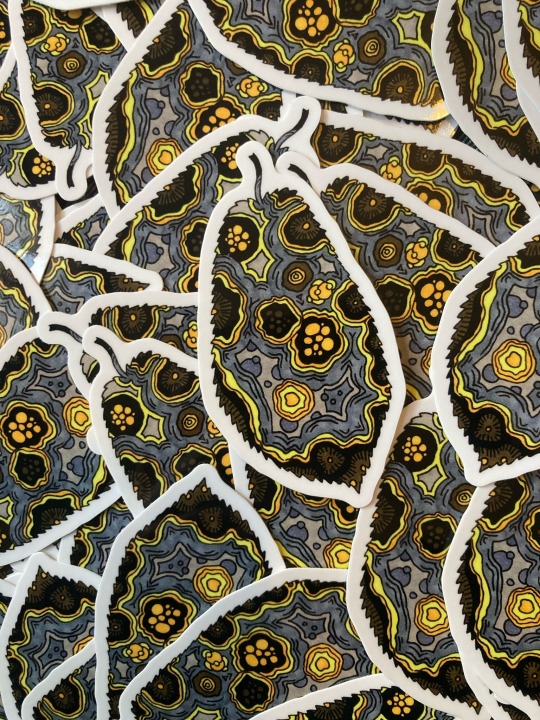
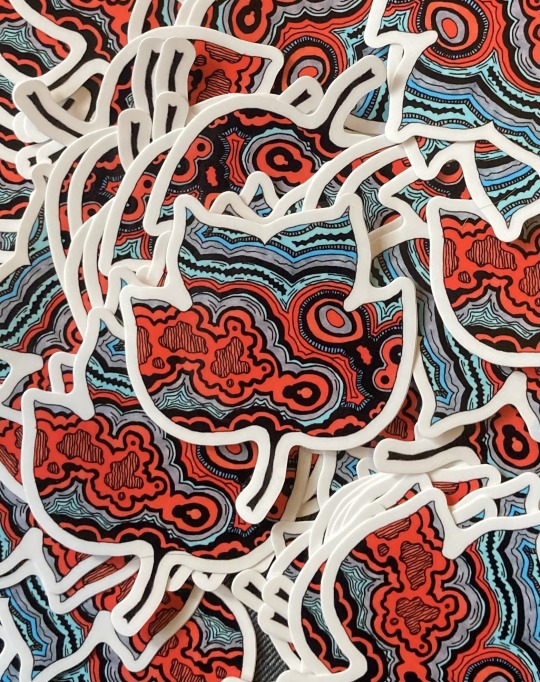
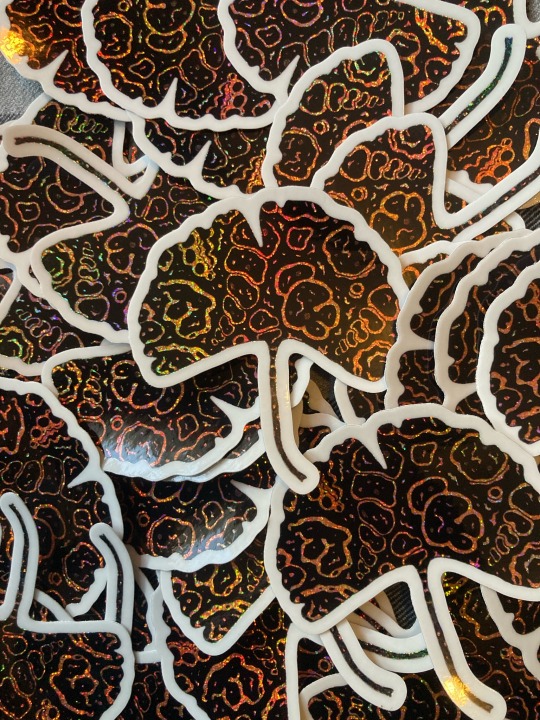
New leaf geode stickers!!!
Prunus geode, tulip tree agate, and ginkgo Turritella fossils 🍂🪨
#illustration#my work#drawing#art#creature#natural history#botanical illustration#botanical art#sticker#sticker art#art sticker#art stickers#stickers#leaf sticker#vinyl sticker#vinyl stickers#waterproof stickers#waterproof sticker#stickerninja
5 notes
·
View notes
Text
Ginkgo biloba, 银杏.
Another watercolour, 2023-10-03.

Another gift that I had prepared for my partner was this painting of a ginkgo leaf. Ginkgoes have always been one of my favourite trees, and I have been so lucky to be able to see them in person (they're not native where I come from).
Ginkgo trees represent many things that I hope for in my partnership. Firstly, ginkgo leaves are often bilobed, with two lobes merging into one leaf. It has been taken as a sign of harmony and love, the unity of two parts that cannot be separated. Secondly, ginkgoes are trees that live long lives, often many centuries long. This makes them a symbol of longevity and health. Combining both meanings, (love and longevity) we get the third symbolism of the ginkgo — eternal love and fertility.
Also, fun fact: Ginkgo trees are so old that they are considered living fossils. They are so old that they still retain flagellated male gametes! Swim on, my little ginkgo sperm!
0 notes
Text
Ginkgo trees nearly went extinct. Here’s how we saved these ‘living fossils.’
Released October 4, 2023
7 minutes checked out
On the streets of Manhattan and Washington, D.C., in areas in Seoul and parks in Paris, ginkgo trees are slowly losing their intense yellow leaves in response to the very first bout of freezing winter season air.
This leaf drop, progressive initially, and after that abrupt, carpets streets with golden, fan-shaped leaves every year. Around the world,…

View On WordPress
0 notes
Text
Ginkgo Leaf Tattoo Meaning: Exploring the Symbolic Significance of This Ancient Symbol - Impeccable Nest
The ginkgo tree, native to China and considered a living fossil, has existed for millions of years. Its distinct fan-shaped leaves have long been associated with various meanings, including longevity, resilience, and adaptability. By adorning oneself with this timeless emblem, individuals embody these qualities and acknowledge the inherent interconnectedness of all life forms. The ginkgo leaf tattoo serves as a constant reminder of our place within the grand tapestry of nature. It acts as a tangible link connecting us to the earth’s energies, grounding us in the present moment and fostering a deep sense of peace. This connection can be particularly meaningful for those who find solace, inspiration, and spiritual fulfillment in the natural world. Furthermore, the ginkgo leaf represents growth and transformation, as the tree itself has survived countless - r4i87ipcsf
https://linkhay.com/link/6502179/ginkgo-leaf-tattoo-meaning-exploring-the-symbolic-significance-of-this-ancient-symbol-impeccable

0 notes
Text
Why I Hunt for Sidewalk Fossils
https://sciencespies.com/news/why-i-hunt-for-sidewalk-fossils/
Why I Hunt for Sidewalk Fossils
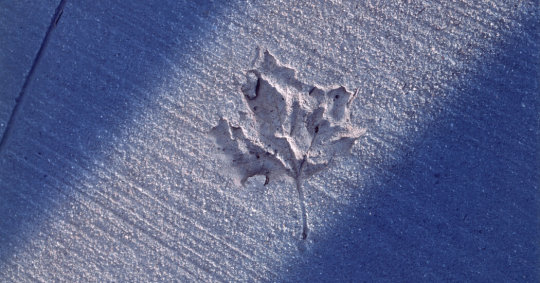
These oft-overlooked records invite us to imagine what has been and what might be.
A paleontologist once told me that city sidewalks hold snapshots. If I trained my gaze toward my feet, he said, I would find evidence of all kinds of commutes: traces of hopping birds, the soles of humans’ shoes, restless leaves that fell and sank into wet concrete at just the right moment. I might see a smattering of little paw prints zigging, zagging, doubling back, evidence of important rodent business that didn’t often overlap with mine.
These marks are too recent to pass muster with scientific sticklers, but in all respects except age, they are fossils. There are many ways to make one. Some form when a creature is entombed in sediment: Water percolates through, flush with minerals, and over time the mixture infiltrates the bones, where it settles and forms stone. Other fossils are casts, made, for instance, when a shell dissolves and leaves behind a mold that eventually fills with sediment, which hardens into rock. But not all fossils involve remains; some catalog movements. These are the kind that stipple our sidewalks — nascent trace fossils, records of fleeting contact.
Throughout the pandemic, I turned to nature to track time and step outside myself. I photographed the sweetgum tree outside my Brooklyn window, noting when it leafed into a bushy chlorophylled curtain or when it dropped fruit that fell to the ground like unshattered ornaments. Most afternoons of that first lonely spring, I roamed a cemetery. When magnolia blossoms smudged the scene pink, I stood under the canopies until wind splashed the petals against my shoulders.
More on Birds
An Epic Flight: In search of an endless summer, bar-tailed godwits fly 7,000 miles each year — from Alaska to New Zealand. And they do it without stopping to eat, drink or rest.
An Uneven Crisis: The risk of extinction, a study suggests, is not randomly or equally spread across the avian family. Instead, the most distinctive birds are likely to vanish first.
Hammering Away: A study shows that woodpeckers do not absorb shocks during pecking and they likely aren’t being concussed either.
A Beloved Bird Call: The corncrake’s loud cry was once a common sound of summer in Ireland, but these days it can seldom be heard. Efforts are underway to bring it back.
I was lucky, of course, to be simply scared and lonely — not dead, not intubated, not choosing between peril and paycheck. But time was slippery, and I felt stuck in my own brain, a foggy, trembling ecosystem I had no interest in studying. By early 2022, I was cocooned in my partner’s Morningside Heights apartment. On weekend mornings, we shuffled around the neighborhood, and each volunteered to notice something new: a startling mushroom, the pale bellies of pigeons waterfalling down a facade before flocking skyward. I became fixated on sidewalk fossils. Fossil-finding outings were a relief — an invitation to crouch, touch, lose myself in evidence of skittering and scrabbling, tethering myself to a past and a future.
Once I started noticing these impressions, it was fun to imagine myself as a paleontologist of the urban present.
Because sidewalk fossils are essentially the same color as the surrounding concrete, they’re most visible when light rakes across them; a fossil that’s elusive at noon might announce itself at dawn or dusk. So I timed a second daily walk for the hour when the light fled. Late afternoons introduced me to tiny forked footprints that marked the scene of, perhaps, an avian skirmish. There were others: a dog’s paws, three-quarters of a shoe. Though ichnologists, who study trace fossils, might discount leaves, I marveled at those too: most of a London plane and a ginkgo, with its corrugated fan. Across from a closed-up snack cart, I knelt until the cold concrete prickled my knees. I wriggled out of my mitten and traced a leaf’s sharp, diagonal veins, its saw-toothed sides.
When scientists encounter a fossil, they often try to puzzle out an explanation of how it got there. Maybe an animal was stranded or washed off its feet or chased by predators. Once I started noticing these impressions, it was fun to imagine myself as a paleontologist of the urban present. A bonanza of bird feet made me wonder if someone had sprinkled seeds or dropped a bagel. How long ago? What kind? When a leaf didn’t seem to match any of the nearby trees, I wondered if it was an interloper, blown in from blocks away or if it testified to an ecological eviction — a tree yanked out and replaced with another species or swapped for sidewalk. The fossils fastened my attention to something tangible but also invited it to wander and to think about city streets as collages of past and present, about how our nonhuman neighbors are architects, too. How we all shed traces of ourselves, whether we know it or not.
Of course, there is more significant proof of the past. Mammoths sometimes turn up in farmers’ fields, their tusks curved like scythes abandoned in the dirt. Parades of dinosaur footprints still march along the banks or beds of some prehistoric rivers and seas. Those are awesome, showy and obvious. I line up to see them; I happily gawk. But it was a tiny thrill to encounter evidence of the past that was subtle and recent, proof that others were out there. The sidewalk fossils felt intimate — the paleontological equivalent of a raft of letters secreted away beneath a floorboard.
Only they’re not actually rare. When sidewalks are repaired, birds and other animals ignore attempts to keep them pristine. Leaves do whatever the wind demands. These fossils are easy to find, and we’re lucky to have them. When I was lingering in the worst parts of my brain, sidewalk fossils dislodged me. Unlike the many fossils that represent stillness, the moment when an animal died and the place it remained unless humans carved it free, sidewalk fossils are often peeks into lives that continued. The birds flew somewhere; the dogs, I hope, went on to wag over many sticks and smells. As the sun sank and I trudged home, the fossils — these little flukes, these interesting accidents — were reminders of small, exhilarating life.
Jessica Leigh Hester is a science journalist whose first book is “Sewer” (Bloomsbury Academic, 2022).
#News
0 notes
Photo
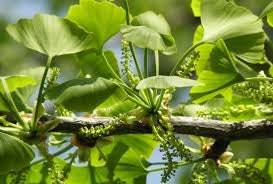
GINKGO BILOBA Seeds Maidenhair or Bonsai seeds #5 Seed Count: 5 seeds Native to China, the ginkgo Biloba tree (of the Ginkgoaceae family) is distinguished by its wide, leathery, fan-shaped leaves and sturdy trunk. The name is derived from the Japanese word ginkgo, meaning "silver apricot." Ginkgos are known for their remarkable longevity; some trees growing in China are over 2500 years old. In the United States, they grow in hardiness zones 3 to 9. Unfortunately, these trees are also notorious for the horrid smell--similar to vomit or rotten eggs--produced by seeds that fall and rot. From a distance, though, ginkgo trees are beautiful. How to Grow? Remove the pulp from the seeds by washing in water. Spread out the clean seeds on paper towels to dry. Prepare a potting mixture of equal parts compost, soil, peat moss, and sand. Plant the seeds in growing trays filled with the potting mixture. Cover with 1/4 inch of the mixture, keep them evenly moist, and place in a warm and humid spot until they germinate. Transplant them to a permanent location when growth is 3 to 4 inches tall. This ancient deciduous tree has a large crown composed of sparse branches covered with interesting lobed, fan-shaped leaves that are unlike those of any other tree. They turn captivating shades of gold in fall and drop quickly, creating a bright carpet that slowly fades to brown. In the winter, its stark, deeply furrowed, grayish tanbark and knobby branches add additional landscape interest. It is the last surviving species in Ginkgoaceae, a plant family that has existed for 150 million years, according to the fossil record. Genus - Ginkgo Species - Biloba Common name - Maidenhair Tree Pre-Treatment - Not required, but recommended Hardiness zones - 4 - 8 Height - 50-100' / 15 - 30 m Spread - 30-50' / 9 - 15 m Plant type - Tree Vegetation type - Deciduous Exposure - Full Sun Growth rate - Medium Soil PH - Acidic, Neutral, Alkaline Soil type - Clay, loam, sand, well-drained Water requirements - Average Water, drought tolerant Landscape uses - Feature Plant, Shade Trees, Street Trees, Topiary / Bonsai / Espalier Leaf / Flower color - Green, Yellow Green, in autumn - yellow, gold / Yellow Green Plant growth rate - Medium http://springsofeden.myshopify.com/products/ginkgo-biloba-seeds-maidenhair-or-bonsai-seeds-5
1 note
·
View note
Text
Awkward Botanical Sketches #3: The Ginkgo Edition
Awkward Botanical Sketches #3: The Ginkgo Edition

For most of my life, ginkgo has been a meaningful tree to me. I remember first learning about it as a fourth grader. Our teacher had assigned us each to make a leaf collection. My grandparents heard about my assignment and sent me a ginkgo leaf from a tree growing in their front yard. It was unlike any other leaf in my collection, and it had a fascinating back story. Not only is it the only…
View On WordPress
#artwork#awkward#botanical art#botanical illustrations#coloring#drawings#Fossil Atmospheres#ginkgo#Ginkgo biloba#ginkgo leaves#Grow Curious#leaf collection#leaf rubbings#leaves#living fossil#sketches#Smithsonian#Staple Day#Trees
45 notes
·
View notes
Text

wanted to try my hand at one of those wikipedia excerpt poems. title: “the ginko stays”
transcript under the cut
the diversity of uses and meanings
combined with the complexity of the feelings involved
makes love unusually difficult to consistently define
scientists found
170 million-year-old fossil
ginkgo leaves
have endured to the present day,
as if the fossil had “come to life again.”
the color wheel theory of love.
during autumn, the leaves turn a bright yellow, then fall,
sometimes for years.
the universe goes through repeated cycles
with each cycle lasting 4,320 million years.
the ginkgo stays
the existence of altruism in nature is at first sight puzzling,
such love might exist between family members,
“unconditional selflessness” to a tree.
ancient greek philosophers identified six forms of love:
flower, leaf, stem, bark, root, seed.
six gingko biloba specimens survived the atomic bombing of hiroshima,
1 to 2 kilometers from ground zero.
they still live there today.
2K notes
·
View notes
Text
Do You Remember When? (Epilogue)
Written for @levihanweek Day 6: Memory and Day 7: Free Space. This is a continuation of the other fic I wrote which you can find here!
Part 1
A/N:
Levi and Hange are 24 when they meet again and 29 when they get married
Thank you @levihanweek for hosting Levihan Week and @immagoudaboi for beta reading!
Enjoy!
Levi believed, with all his heart, that he was in some cheesy romantic movie or a shitty fanfic. Like the ones where there are 2 childhood friends, they separate, meet again, and fall in love after all those years.
Well, now that movie/book had ended and opened up to the sequel: the marriage.
Levi stared at himself while he adjusted the tie in the mirror. He was currently getting ready for his big day, and he also wanted to be alone for a few minutes. Here he was at a stage in life he never expected. Marrying his childhood crush, Hange.
The couple decided to keep their marriage small. Only close friends and families were allowed to witness the event. Luckily they found a small botanical garden that was perfect for the venue, reception, and sunset photoshoots. Plus, the garden had a section dedicated to sunflowers, a flower that makes Levi smile every time he sees it. Overall, it was perfect for the couple.
Levi still remembered the day they reunited. It was only 5 years ago when Hange was with Erwin, and Levi swore Erwin would introduce her as his lover. Boy, was he wrong.
Levi made a mental note to thank whoever above for not including that.
(Np Levi)
His relationship with Hange developed smoothly for the most part. Sure there were rough patches along the way, but the two always overcame it. Thus their love grew stronger as the years progressed.
Their first date started as a simple fancy homemade dinner. It was quiet and peaceful. The couple had even sung some karaoke and ended the night waltzing to jazz music.
The second date was a whole 180. This date included Levi's 2021 Ducati XDiavel Black Star
motorcycle. It was a gift given to him by his uncle and all the gambling money he earned. The bike alone took Hange's breath away.
---
Hange let out a loud whistle as she eyed the Ducati. The motorcycle was very sleek, black, gray, and had a few hints of red. Overall, it screamed Levi.
"Levi! I didn't know you owned a Ducati! Do you know how much they are? Over 20k!" Hange exclaimed with stars in her eyes. Levi smirked before walking up to her side. He wrapped an arm around her waist and rested his head on her shoulder.
"Actually, this bike was a gift from Kenny. He won enough at the casino and bought it for me for my 24th birthday."
Hange fondly smiled at the thought. She knew Kenny always had a soft spot for Levi since he is his only nephew.
"You know what we should do now, Levi?" Hange's smile turned into a full grin. "Let's take it for a spin!"
Levi took his head off of Hanges shoulder and looked at her with shock. "Just like 10 years ago?"
"Yes! But…." Her voice trailed off, and she stared down at her feet. "Can I drive it this time?"
Levi's jaw dropped, and he just stared at her. Hange waved a hand in front of his face.
"Levi? Are you there?"
"I heard you. It's just….are you sure?" He asked with worry, and Hange chuckled at how cute he looked.
"No need to worry about me, Levi. Mike used to let me drive his motorcycle around, so I know what to do."
"He let you do what?!" Levi became horrified. Why didn't Mike ever mention this to him?
Hange waved a hand nonchalantly. "I only had minor scrapes when I first started, but I managed to pick it up quickly. Just like you!"
-----
"So, where do you want to go?" Hange asked Levi, who wrapped his arms around her waist. The motorcycle purred with life, and the two had their helmets secured on their heads. The only thing left to do was actually leave Levi's garage.
"I'm okay with going anywhere. Just as long as I’m with you."
"Really? You don't mind driving us off the cliff?" Hange teased and laughed at her own suggestion.
Levi rolled his eyes but smirked along with Hange. "No, and nowhere reckless, Four-Eyes. Got it?"
Hange did a mini salute before facing forward and positioning herself to take off. "Yes, sir! Besides, I know the perfect place to go."
Levi decided to not question where Hange wanted to bring him. He trusted her enough to know that wherever she brought him will hold significance to the both of them.
Levi rested his head against Hange's back as she took off. He watched the city pass by in a blur while listening to Hange's merry laugh. It was like music to his ears despite the other sounds in the background. He kept his focus on Hange only.
Hange zoomed and zigzagged through the city. What felt like seconds, was actually hours when they arrived at their destination. Levi's eyes widened in recognition.
"Is this?" Levi asked Hange, and she nodded.
In front of Levi was the same park he took her to several years ago. The park itself had been updated in the past 10 years since the time he and Hange last snuck out. There were multiple colorful flowers and trees planted all over to provide more natural shade. Additionally, the city added more benches so people could sit down and enjoy the scenery.
Hange parked the motorcycle so she and Levi could get off. She extended her hand out to Levi (which he gladly accepted) and led him to the hill, where they shared their first kiss.
This time, there was a giant ginkgo tree with bright yellow leaves on the branches. The autumn breeze blew some of the leaves off to float in the air as if they were dancing. Hange let go of Levi to run up ahead and go under the tree.
It was an amazing sight for Levi to witness: from below the tree, Hange watched the leaves fall. She spread her arms out and laughed as the leaves began dancing around her body like it was people worshiping a goddess.
Boy was Levi in love.
"Levi! Come join me." Hange called out to him as the ginkgo leaves started decorating her brown hair.
Levi strode over to Hange and reached up to her head when he was close enough. He plucked a yellow leaf out of Hange's hair and brought it close to examine it.
"Did you know that the ginkgo leaf is considered a living fossil, and it symbolizes hope and peace in China? Additionally, it also survived the Hiroshima bombing, so it also symbolizes endurance and vitality."
Suddenly, Hange's face became serious, and she clasped her hands over Levi's. The yellow ginkgo leaf remained in Levi's grasp.
"Levi, I'm sorry about our falling out in the past."
"Hange, you don't need to apologize-"
Hange shut Levi up by pressing a finger to his lips.
"Let me finish." She added and retracted her finger. "I want this relationship-" she gestured between the two of them. "To be like the ginkgo leaf. Do you want to know why?" She quietly added.
Levi remained quiet but nodded his head, so Hange could continue.
"I want us to endure through every challenge we face together. Until we die. I want us to someday live together, have kids, and keep making happy memories. I know this is our second date, but I have always loved you, Levi. I want you to know that, but I don't expect you to--"
Hange never finished her rambling when Levi swiftly grabbed Hange by the back of her head and brought his lips to hers. She dropped her hands down and brought Levi close to her.
Levi didn't need to vocalize anything, but Hange already knew. It was like telepathy between the two of them; Levi loved her too.
The couple was preoccupied with their embrace to notice the yellow ginkgo leaf flutter down and land softly on the grass.
---
Levi smiled at the declaration of love under the ginkgo tree. The leaf Levi held was now pressed in a frame that sat in the couple's living room. It was a constant reminder of a new start in their lives. It symbolized turning a new leaf for the two.
Levi moved on to add the boutonniere to his suit. The item itself was made up of fake (because it saves money and lasts longer. Hange’s words, not his) sunflowers. Levi smiled after he finally pinned the boutonniere.
Boy, was he in love with Hange.
The door rattling interrupted Levi's thoughts of his fiance, and he clicked his tongue in annoyance.
"Mike! Erwin! I told you to knock before coming in-" Levi complained and turned around to glare at the intruder, only to be greeted by his fiance instead.
"Here. Hange?!" He exclaimed, and Hange chuckled.
"Oh, Levi. You know I don't knock when I enter the room. Especially the bedroom. I always catch you at the perfect times." She chuckled and wiggled her eyebrows. Levi blushed and looked away out of embarrassment.
"Why are you here? What about the whole 'seeing the bride before the wedding thing?'" Levi added, and Hange rolled her eyes.
"I could care less about that whole superstition shit, Levi. You know that."
Levi looked at Hange with concern. "What are you doing here anyway? Is something wrong?"
Hange fake gasped and widened her eyes. "Is it wrong for me to see my future husband on our wedding day?" She slumped her shoulders and strode over to stand next to Levi. Levi, noticing Hange’s distress, led her to sit down on a nearby sofa.
"Levi, to be honest, I'm nervous, and I just wanted to see you.”She admitted, wrapped her arms around Levi, and buried her face in the crook of his neck. She was careful enough to not ruin her makeup and hair.
Levi hugged Hange back and rubbed her back. "Your bridesmaids must be worried about you right now. Did you go ‘bridezilla’ on them?"
Hange laughed and looked up at Levi. He looked down at her in return. "Worse, but you don't need to know that."
Levi chuckled, and silence enveloped the two. It was nice, just sitting alone together in tranquility. This was their time to share before the ceremony. Sure, there might be chaos outside the room, but Levi and Hange were together. They endured every challenge like the ginkgo tree. The couple was also like a sunflower and the sun: facing each other until the end of the day.
-------
©: This is where I insert all rights reserved stuff. This story belongs to me. Do not modify or republish.
A/N:
I wrote 3 different wedding au's so far and I find that hilarious!
Thank you @cat for the suggestion! This is late but I was inspired to write more 😁
26 notes
·
View notes
Note
Ok so idk if Tumblr is actually gonna send all 3 pics but the first one is Metasequoia, this specimen is from the Oligocene abt 33.9 MYA, the second is a beautiful ginkgo, that specimen is from the Paleocene, 56 MYA! Both Metasequoia and ginkgos are living fossils, they're both still around today! Though gingkos imo, are the more impressive of the two. The third is a Daphnogene polymorpha, and that specific one is from the Miocene and is abt 15 myo! So far these are my only plants but I have a number of other cool fossils, crystals and minerals 👉👈 I hope you enjoy my very old dead leafs




Oh those are lovely!! I think I may in fact get emotional (again) over ancient plants that still exist, because how lucky are we to still exist in the same space as organisms that existed millions of years ago!!
Thank you for sharing your very old dead leafs!
33 notes
·
View notes